语音学和音位学 练习题
- 格式:doc
- 大小:30.00 KB
- 文档页数:2
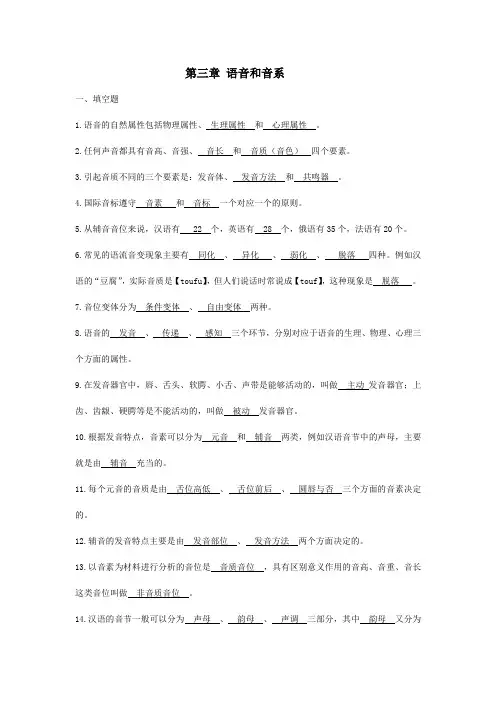
第三章语音和音系一、填空题1.语音的自然属性包括物理属性、生理属性和心理属性。
2.任何声音都具有音高、音强、音长和音质(音色)四个要素。
3.引起音质不同的三个要素是:发音体、发音方法和共鸣器。
4.国际音标遵守音素和音标一个对应一个的原则。
5.从辅音音位来说,汉语有 22 个,英语有 28 个,俄语有35个,法语有20个。
6.常见的语流音变现象主要有同化、异化、弱化、脱落四种。
例如汉语的“豆腐”,实际音质是【toufu】,但人们说话时常说成【touf】,这种现象是脱落。
7.音位变体分为条件变体、自由变体两种。
8.语音的发音、传递、感知三个环节,分别对应于语音的生理、物理、心理三个方面的属性。
9.在发音器官中,唇、舌头、软腭、小舌、声带是能够活动的,叫做主动发音器官;上齿、齿龈、硬腭等是不能活动的,叫做被动发音器官。
10.根据发音特点,音素可以分为元音和辅音两类,例如汉语音节中的声母,主要就是由辅音充当的。
11.每个元音的音质是由舌位高低、舌位前后、圆唇与否三个方面的音素决定的。
12.辅音的发音特点主要是由发音部位、发音方法两个方面决定的。
13.以音素为材料进行分析的音位是音质音位,具有区别意义作用的音高、音重、音长这类音位叫做非音质音位。
14.汉语的音节一般可以分为声母、韵母、声调三部分,其中韵母又分为韵头、韵腹、韵尾三部分。
15.汉语的调位可以分为阴平、阳平、上声、去声四类,其调值分别是55 、 35 、 214 、 51 。
二、判断题1.语音的最小单位是音节。
(×)2.男子声音和女子声音的差别主要是音长不同。
(×)3.儿童的声音和成人的声音的差别主要是音长不同。
(×)4.发音时,声带是否振动、气流是否强,都能形成不同的音素。
(×)5.肺是人类发音的动力站,声带是发音体。
(√)6.口腔中最为灵活的发音器官是上齿。
(×)7.元音发音时,声带不一定振动,辅音发音时,声带一定要振动。
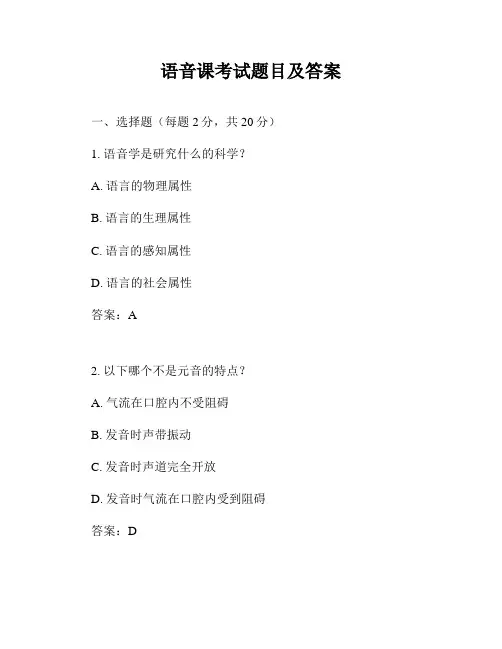
语音课考试题目及答案一、选择题(每题2分,共20分)1. 语音学是研究什么的科学?A. 语言的物理属性B. 语言的生理属性C. 语言的感知属性D. 语言的社会属性答案:A2. 以下哪个不是元音的特点?A. 气流在口腔内不受阻碍B. 发音时声带振动C. 发音时声道完全开放D. 发音时气流在口腔内受到阻碍答案:D3. 辅音的发音特点是?A. 气流在口腔内不受阻碍B. 发音时声带振动C. 发音时声道完全开放D. 发音时气流在口腔内受到阻碍答案:D4. 以下哪个音素是浊音?A. /p/B. /t/C. /k/D. /b/答案:D5. 以下哪个音素是清音?A. /b/B. /d/C. /g/答案:D6. 以下哪个音素是鼻音?A. /m/B. /n/C. /ŋ/D. 所有以上答案:D7. 以下哪个音素是塞音?A. /s/B. /z/C. /p/D. /f/答案:C8. 以下哪个音素是擦音?B. /v/C. /s/D. /ʃ/答案:C9. 以下哪个音素是塞擦音?A. /t/B. /d/C. /ʧ/D. /ʤ/答案:C10. 以下哪个音素是近音?A. /l/B. /r/C. /w/D. /j/答案:B二、填空题(每题2分,共20分)1. 语音学中,________是指声音的高低,由声带的振动频率决定。
答案:音高2. 语音学中,________是指声音的强弱,由声波的振幅决定。
答案:音强3. 语音学中,________是指声音的长短,由声波的持续时间决定。
答案:音长4. 语音学中,________是指声音的清晰度,由声波的频率分布决定。
答案:音质5. 元音的发音特点是气流在口腔内________。
答案:不受阻碍6. 辅音的发音特点是气流在口腔内________。
答案:受到阻碍7. 浊音是指发音时________振动的声音。
答案:声带8. 清音是指发音时________不振动的声音。
答案:声带9. 鼻音是指气流从________流出的声音。
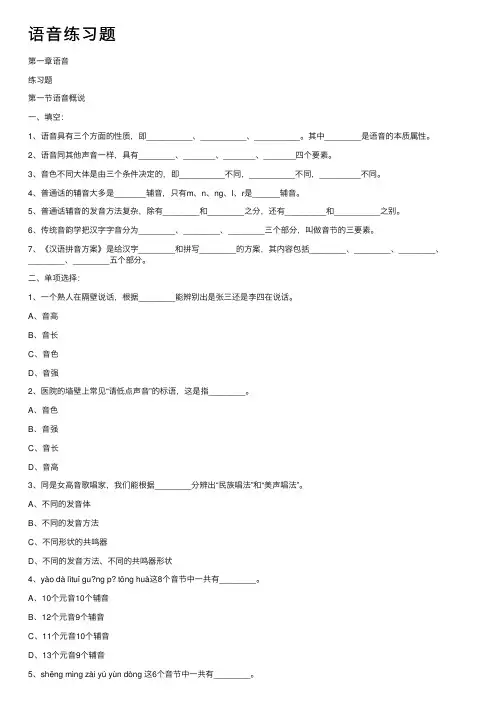
语⾳练习题第⼀章语⾳练习题第⼀节语⾳概说⼀、填空:1、语⾳具有三个⽅⾯的性质,即__________、__________、__________。
其中________是语⾳的本质属性。
2、语⾳同其他声⾳⼀样,具有________、_______、_______、_______四个要素。
3、⾳⾊不同⼤体是由三个条件决定的,即__________不同,__________不同,_________不同。
4、普通话的辅⾳⼤多是_______辅⾳,只有m、n、ng、l、r是______辅⾳。
5、普通话辅⾳的发⾳⽅法复杂,除有________和________之分,还有_________和__________之别。
6、传统⾳韵学把汉字字⾳分为________、________、________三个部分,叫做⾳节的三要素。
7、《汉语拼⾳⽅案》是给汉字________和拼写________的⽅案,其内容包括________、________、________、________、________五个部分。
⼆、单项选择:1、⼀个熟⼈在隔壁说话,根据________能辨别出是张三还是李四在说话。
A、⾳⾼B、⾳长C、⾳⾊D、⾳强2、医院的墙壁上常见“请低点声⾳”的标语,这是指________。
A、⾳⾊B、⾳强C、⾳长D、⾳⾼3、同是⼥⾼⾳歌唱家,我们能根据________分辨出“民族唱法”和“美声唱法”。
A、不同的发⾳体B、不同的发⾳⽅法C、不同形状的共鸣器D、不同的发⾳⽅法、不同的共鸣器形状4、yào dà lìtuī gu?ng p? tōng huà这8个⾳节中⼀共有________。
A、10个元⾳10个辅⾳B、12个元⾳9个辅⾳C、11个元⾳10个辅⾳D、13个元⾳9个辅⾳5、shēng mìng zài yú yùn dòng 这6个⾳节中⼀共有________。
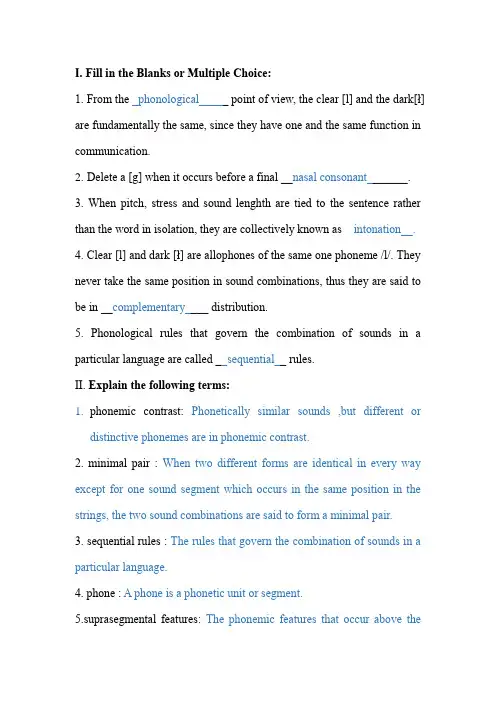
I.Fill in the Blanks or Multiple Choice:1. From the _phonological_____ point of view, the clear [l] and the dark[ł] are fundamentally the same, since they have one and the same function in communication.2.Delete a [g] when it occurs before a final __nasal consonant_______.3. When pitch, stress and sound lenghth are tied to the sentence rather than the word in isolation, they are collectively known as intonation__.4. Clear [l] and dark [ł] are allophones of the same one phoneme /l/. They never take the same position in sound combinations, thus they are said to be in __complementary____ distribution.5. Phonological rules that govern the combination of sounds in a particular language are called __sequential__ rules.II. Explain the following terms:1.phonemic contrast: Phonetically similar sounds ,but different ordistinctive phonemes are in phonemic contrast.2. minimal pair : When two different forms are identical in every way except for one sound segment which occurs in the same position in the strings, the two sound combinations are said to form a minimal pair.3. sequential rules : The rules that govern the combination of sounds in a particular language.4. phone : A phone is a phonetic unit or segment.5.suprasegmental features: The phonemic features that occur above thelevel of the segments are called suprasegmental features.III. Do the followings:1.How do phonetics and phonology differ in their focus of study? Answer:Phonetics is of a general nature,it is interested in all the speech sounds used in all human languages.Phonology aims to discover how speech sounds in a language form patterns and how these sounds are used to convey meaning in linguistic communication.Though both dealing with speech sounds,phonetics and phonology differ in their focus of study in that the former focuses on the speech sounds themselves,their ways of pronunciation,their differences,their classifications,etc.,while the latter focuses on the sound system of particular languages and the role sounds play in conveying meaning.Therefore,a phoneticianwill be more interested in the difference between two sounds.2.How is phone different from a phoneme? How are allophones relatedto a phoneme?Answer:A phone is a phonetic unit or segment.The speech sounds we hear and produce during linguistic communication are all phones.A phoneme is a phonological unit,it is a unit that is of distinctive value.It is an abstract unit.It is not particular sound,but rather itis represented or realized by a certain phone in a certain phonetic context.Allophones are the different phones which can represent a phoneme in different phonetic environments.A phone is simply a speech sound,every actual sound we use or hear in meaningful linguistic communication.For example,in pronouncing the two words“feel”and“leaf”,we actually use or hear fourphones:[f][i:][l]and[~l].A phone differs from a phoneme in that the former is an actual sound we hear and it is the unit of study in phonetics,and the latter is not an audible sound,but an abstract entity,a collection of phonetic features,used as a unit of study in phonology.Take the“feel”and“leaf”example again.While four phones are used or heard in the pronunciation of these two words, only three phonemes are involved,i.e./f//i:/and/l/.A phoneme, though as an abstract entity,is realized as different phones in different phonetic contexts.All these different phones are called the allophones of the same one phoneme.For example,the aspirated [pʰ]and the unaspirated[p]are allophones of the same phoneme/p/.3.How do the major suprasegmental features of English function inconveying meaning?Answer:Suprasegmental features refer to those phonological features occurring above the sound segment level.The major Suprasegmentalfeatures in English are stress and intonation.The shift of word stress may change the part of speech of words of the same spelling, such as“'progress n.”and“pro'gress v.”,and different stress may cause difference in the meaning of some compound nouns and noun phrases with the same components,such as“'hotdog”and “hot'dog”.Stressing words that are normally unstressed in a sentence may convey some extra meaning by the speaker.For example,by stressing the pronoun“my”in the sentence“He is driving'my car”the speaker is emphasizing the fact that the car he is driving is no one else`s but the speaker`s.The three often-used intonations in English are the falling tone,the rising tone,and the fall-rise tone.The basic role they each play is that the falling tone states a fact,the rising tone raises a question,and the fall-raise tone implies some meaning not literally expressed.For example,the same sentence“That`s not the book he wants”said in the three different intonations convey three different meanings.4.Please use Sequential Rules to explain the combination of the threeconsonants in the following words: spring[sprŋ], strict[strikt], square[skwɛə], scream[skri:m].Answer:Sequential rules refer to the ways the phonemes can be combined. Sequential rules regulate which phonemes can begin a word,end aword,and follow each other.They are rules that govern the combination of sounds in a particular language.For example,if a word begins with a[l]or a[r],then the next sound must be a vowel.That is why[lbik][lkbi]are impossible combinations in English.They have violated the restrictions on the sequencing of phonemes.For example,why“klib”is a permissible combination of the four sounds in English and why“kbli”is not can only be accounted for by a sequential rule.spring[sprŋ], strict[strikt], square[skwɛə], scream[skri:m] follow three rules:1.The first phoneme must be /s/.2.The second phoneme must be /p/,/t/,/k/.3.The third phoneme must be /l/./r/,/w/.5.Please use Assimilation Rule to explain the following phenomenon:the negative forms of plausible, legal, regular are impossible, illegal and irregular.Answer:The assimilation rule assimilates one sound to another by“copying”a feature of a sequential phoneme,thus making the two phones similar.For example,the[i:]sound is nasalized in words like bean, green,team,and scream.This is because in all these sound combinations the[i:]sound is followed by a nasal[n]or[m]Forexample,the actual pronunciation of the letter“n”in the word “incorrect”is not the alveolar[n]but the velar nasal[ŋ]is a manifestation of the assimilation rule at work..The sound assimilation is actually reflected in the spelling in most cases. Instead of inpossible, the negative form of possible is impossible, as the [n] sound is assimilated to [m].For the same reason, the negative forms of plausible, legal, regular are implausible, illegal, and irregular.。
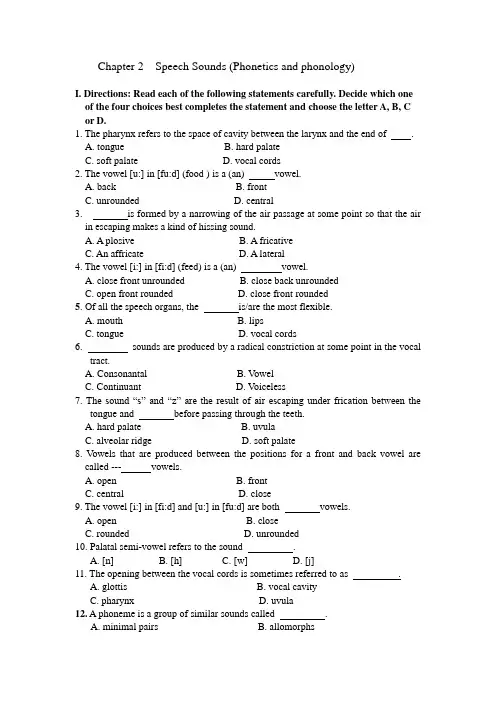
Chapter 2 Speech Sounds (Phonetics and phonology)I. Directions: Read each of the following statements carefully. Decide which one of the four choices best completes the statement and choose the letter A, B, C or D.1. The pharynx refers to the space of cavity between the larynx and the end of .A. tongueB. hard palateC. soft palateD. vocal cords2. The vowel [u:] in [fu:d] (food ) is a (an) vowel.A. backB. frontC. unroundedD. central3. is formed by a narrowing of the air passage at some point so that the air in escaping makes a kind of hissing sound.A. A plosiveB. A fricativeC. An affricateD. A lateral4. The vowel [i:] in [fi:d] (feed) is a (an) vowel.A. close front unroundedB. close back unroundedC. open front roundedD. close front rounded5. Of all the speech organs, the is/are the most flexible.A. mouthB. lipsC. tongueD. vocal cords6. sounds are produced by a radical constriction at some point in the vocaltract.A. ConsonantalB. V owelC. ContinuantD. V oiceless7. The sound “s” and “z” are the result of air escaping under frication between thetongue and before passing through the teeth.A. hard palateB. uvulaC. alveolar ridgeD. soft palate8. V owels that are produced between the positions for a front and back vowel are called --- vowels.A. openB. frontC. centralD. close9. The vowel [i:] in [fi:d] and [u:] in [fu:d] are both vowels.A. openB. closeC. roundedD. unrounded10. Palatal semi-vowel refers to the sound .A. [n]B. [h]C. [w]D. [j]11. The opening between the vocal cords is sometimes referred to as .A. glottisB. vocal cavityC. pharynxD. uvula12. A phoneme is a group of similar sounds called .A. minimal pairsB. allomorphsC. phonesD. allophones13. is a combination of a plosive and a fricative.A. A stopB. A palatalC. A rollD. An affricate14. A sound pronounced with the vocal cords vibrating is said to be a sound.A. resonantB. voicelessC. voicingD. consonant15. Conventionally a (an) is put in slashes.A. allophoneB. phonemeC. phoneD. morpheme16.Of the following sound combinations, only is permissible according tothe sequential rules in English.A. kiblB. bkilC. ilkbD. ilbk17. All the back vowels in English are pronounced with rounded-lips. i. e. rounded,EXCEPT .A. [a:]B. [u:]C. [כ:]D. [u]18. The consonant [f] in English can be correctly described as having the followingphonetic features: .A. viewless, bilabial, stopB. voiceless, labiodental, fricativeC. voiced, bilabial, stopD. voiced, labiodental, fricativeII. Directions: Fill in the blank in each of the following statements with one word, the first letter of which is already given as a clue. Note that you are to fill in ONE word only, and you are not allowed to change the letter given.1. Of the three branches of phonetics, the longest established, and until recently themost highly developed, is a phonetics.2. The four sounds [p],[b], [m] and [w] have one feature in common, i.e., they are allb .3. In English there is a number of d , which are produced by movingfrom one vowel position to another through intervening positions.4. The different phones which can represent a phoneme in different phoneticenvironments are called the a of that phoneme.5. Obstruction between the back of the tongue and the v area results in the pronunciation of [k] and [g].6. A vowel is a voiced sound in forming which the air issues in a continuous stream through the p and mouth, there being no audible friction.7. Conventionally a phoneme is put in slashes, and phones are placed withins brackets.8. The basic unit in phonology is called p ; it is a unit that is of distinctive value.9. P is defined as the study of the phonic medium of language.10. The phonemic features that occur above the level of the segments are calleds features; these are the phonological properties of such units as the syllable, the word, and the sentence.11. When the v is raised, the air cannot escape through the nose and thesound [m], [n], and [η] cannot be made.12. Clear [1] and dark [1] are allophones of the same one phoneme [1]. They nevertake the same position in sound combinations, thus they are said to be inc distribution.13. An essential difference between consonants and vowels is whether the air comingup from the lungs meets with any o when a sound is produced.14. Phonological rules that govern the combination of sounds in a particular languageare called s rules.III. Directions: Judge whether each of the following statements is true or false.Put a T for true or F for false in the brackets in front of each statement. ( ) 1. If a word begins with a [l] or a [r], then the next sound must be a vowel. ( ) 2.V oicing is a phonological feature that distinguishes meaning in both Chinese and English.( ) 3.The consonant sound [p]is described as voiceless alveolar stop.( ) 4. Palatals are sounds articulated by the back of the tongue against the soft palate.( ) 5. If the vocal cords of the larynx are made to vibrate, the accompanying sounds are called voiceless consonants.( ) 6. Phonology provides the means for describing speech sounds.( ) 7. The three voiceless stops [p] [t] [k] are aspirated when preceded by [s] and followed by a vowel.( ) 8. The consonant sound [f] is a voiceless labiodental affricate.( ) 9. When the soft palate is lowered, the air cannot escape through the nose and the nasal sound cannot be made.( ) 10.The stress of a compound always falls on the first element, while the second element receives secondary stress.( ) 11. A sound made with the glottis wide open is called a voiced sound.( ) 12. The [p] sound in “peak” and “speak” is an unas pirated [p].( ) 13. The affricates [t⎰] and [dЗ] can be followed by another sibilant.( ) 14.We use clear [l] before a vowel, such as loaf, and dark[l] at the end of a word after a vowel or before a consonant, such as tell, quilt.( ) 15. English is a tone language.( ) 16. The vowel [u:] in [fu: d] is an open back rounded vowel.( ) 17. In English, long vowels are also tense vowels because when we pronouncea long vowel such as [i:], the larynx is in a state of tension.( ) 18.A general difference between phonetics and phonology is that phonetics is focused on the production of speech sounds while phonology is moreconcerned with how speech sounds distinguish meaning.( ) 19.In classifying the English consonants and vowels, the same criteria can be applied.。
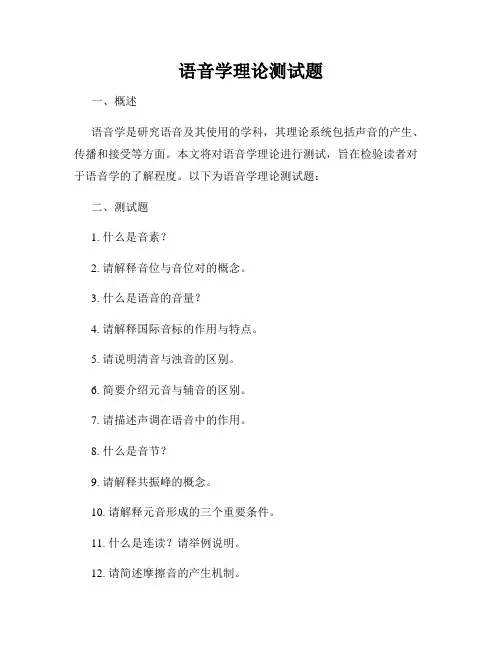
语音学理论测试题一、概述语音学是研究语音及其使用的学科,其理论系统包括声音的产生、传播和接受等方面。
本文将对语音学理论进行测试,旨在检验读者对于语音学的了解程度。
以下为语音学理论测试题:二、测试题1. 什么是音素?2. 请解释音位与音位对的概念。
3. 什么是语音的音量?4. 请解释国际音标的作用与特点。
5. 请说明清音与浊音的区别。
6. 简要介绍元音与辅音的区别。
7. 请描述声调在语音中的作用。
8. 什么是音节?9. 请解释共振峰的概念。
10. 请解释元音形成的三个重要条件。
11. 什么是连读?请举例说明。
12. 请简述摩擦音的产生机制。
13. 请说明辅音的发音方式与特点。
14. 请描述喉音的发音机制。
15. 什么是语音语调?请举例说明不同语音语调的特点。
16. 请解释韵律的概念。
17. 请说明鼻音的发音方式与特点。
18. 请解释辅音的音色。
19. 请简要介绍语音学在语言教学中的应用。
20. 请介绍语音学研究的主要方法。
三、答案解析1. 音素是语言中具有区别意义的最小语音单位。
2. 音位是语言中用于构建词汇和句子的基本音素单位,音位对是指在某一语言中能够区别词义的两个音位。
3. 语音的音量指的是声音的强度或响度,是描述声音强弱的属性。
4. 国际音标是一套用于表示世界上各种语言音素的国际通用符号系统,其作用是记录语音的发音方式,特点是精确、全面。
5. 清音与浊音是辅音的基本特征,清音是指发音时声带不振动的辅音,浊音则相反。
6. 元音是发音时口腔呈开放状态,气流顺畅通过的音。
辅音则是发音时口腔存在较多阻塞,气流只能通过狭窄通道的音。
7. 声调是语言中用来区别词义的音调特征,通过对音高的变化来表达不同的意义。
8. 音节是构成词汇的基本单位,由一个或多个音素组成。
9. 共振峰是发音过程中,由于共振腔体的共振而出现的声音能量集中的频率区域。
10. 元音形成的三个重要条件是受音腔的影响、发声道的通畅和气流的振动。
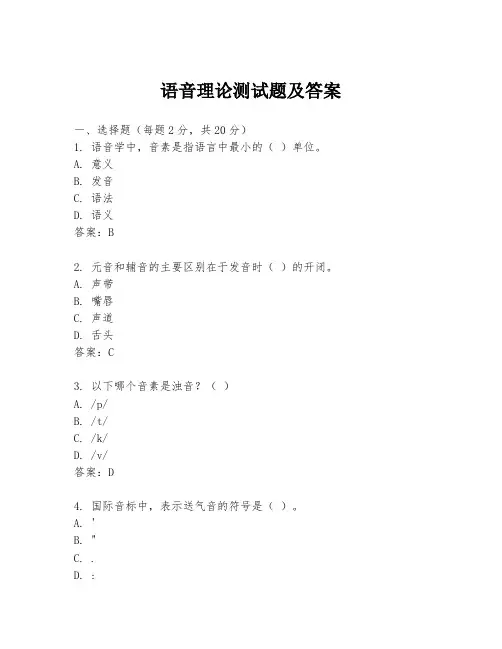
语音理论测试题及答案一、选择题(每题2分,共20分)1. 语音学中,音素是指语言中最小的()单位。
A. 意义B. 发音C. 语法D. 语义答案:B2. 元音和辅音的主要区别在于发音时()的开闭。
A. 声带B. 嘴唇C. 声道D. 舌头答案:C3. 以下哪个音素是浊音?()A. /p/B. /t/C. /k/D. /v/答案:D4. 国际音标中,表示送气音的符号是()。
A. 'B. "C. .D. :5. 以下哪个音素是双唇音?()A. /m/B. /n/C. /l/D. /r/答案:A6. 以下哪个音素是鼻音?()A. /m/B. /p/C. /t/D. /s/答案:A7. 以下哪个音素是擦音?()A. /b/B. /v/C. /f/D. /z/答案:C8. 以下哪个音素是塞音?()A. /s/B. /z/C. /p/D. /l/答案:C9. 以下哪个音素是舌侧音?()B. /r/C. /t/D. /k/答案:A10. 以下哪个音素是半元音?()A. /w/B. /j/C. /m/D. /n/答案:A二、填空题(每题2分,共20分)1. 音素的分类可以根据发音部位和发音方法,其中发音部位包括双唇、唇齿、舌尖、舌面、舌根等。
2. 元音的发音特点是声道完全开放,气流不受阻碍。
3. 辅音的发音特点是声道部分或完全闭合,气流受到阻碍。
4. 清辅音是指发音时声带不振动的辅音。
5. 浊辅音是指发音时声带振动的辅音。
6. 送气音是指发音时气流从肺部送出的辅音。
7. 不送气音是指发音时气流不从肺部送出的辅音。
8. 鼻音是指气流通过鼻腔发出的音。
9. 塞音是指发音时声道完全闭合后突然放开的音。
10. 擦音是指发音时声道部分闭合,气流通过时产生摩擦的音。
三、判断题(每题2分,共20分)1. 音素是语言中最小的语音单位。
(√)2. 元音和辅音的区别在于发音时声带是否振动。
(×)3. 浊音和清音的区别在于发音时声带是否振动。
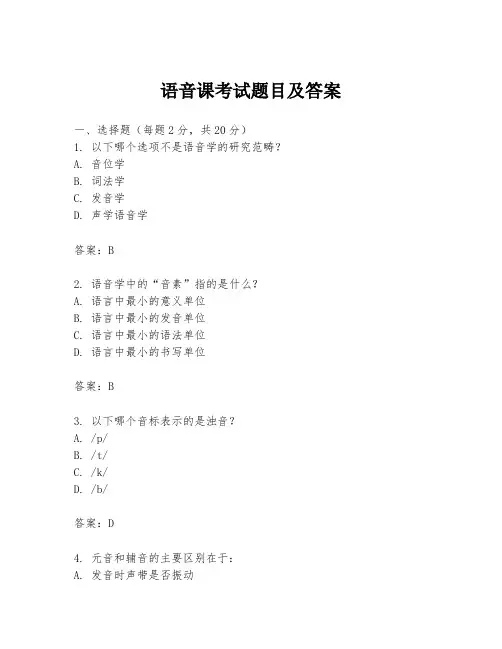
语音课考试题目及答案一、选择题(每题2分,共20分)1. 以下哪个选项不是语音学的研究范畴?A. 音位学B. 词法学C. 发音学D. 声学语音学答案:B2. 语音学中的“音素”指的是什么?A. 语言中最小的意义单位B. 语言中最小的发音单位C. 语言中最小的语法单位D. 语言中最小的书写单位答案:B3. 以下哪个音标表示的是浊音?A. /p/B. /t/C. /k/D. /b/答案:D4. 元音和辅音的主要区别在于:A. 发音时声带是否振动B. 发音时气流是否受阻C. 发音时舌位的高低D. 发音时唇形的圆展答案:A5. 在国际音标中,表示前元音的符号是:A. /i/B. /u/C. /a/D. /e/答案:A6. 下列哪种语言属于声调语言?A. 英语B. 法语C. 汉语D. 德语答案:C7. 以下哪个选项是正确的音节结构?A. CVB. VCC. CVCD. VCV答案:C8. 语音学中,“同位异音”指的是:A. 相同发音位置的两个不同音素B. 相同发音方法的两个不同音素C. 相同发音方式的两个不同音素D. 相同发音效果的两个不同音素答案:D9. 以下哪个选项不是音位变体?A. 自由变体B. 条件变体C. 互补变体D. 语音变体答案:D10. 语音学中,“音位”的概念是由谁提出的?A. 费尔迪南·德·索绪尔B. 诺姆·乔姆斯基C. 列夫·维果茨基D. 丹尼尔·琼斯答案:D二、填空题(每题2分,共20分)1. 语音学是研究______和______的科学。
答案:语音的产生、传播和感知2. 音素的分类包括______、______和______。
答案:元音、辅音、半元音3. 声调是指音高在______上的相对变化。
答案:音节4. 辅音的发音特点是气流在口腔或喉部受到______。
答案:阻碍5. 元音的发音特点是声带振动且气流在口腔内______。
答案:不受阻碍6. 音位变体是指在______中,发音相近或相同,但在意义上______的音素。
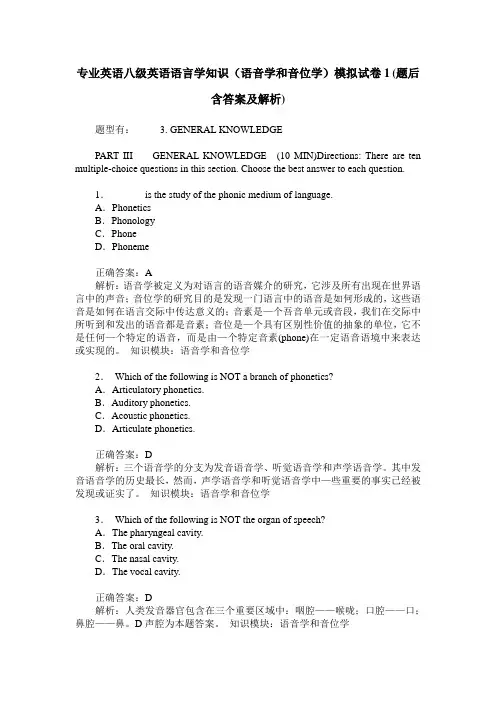
专业英语八级英语语言学知识(语音学和音位学)模拟试卷1(题后含答案及解析)题型有: 3. GENERAL KNOWLEDGEPART III GENERAL KNOWLEDGE (10 MIN)Directions: There are ten multiple-choice questions in this section. Choose the best answer to each question.1.______is the study of the phonic medium of language.A.PhoneticsB.PhonologyC.PhoneD.Phoneme正确答案:A解析:语音学被定义为对语言的语音媒介的研究,它涉及所有出现在世界语言中的声音;音位学的研究目的是发现一门语言中的语音是如何形成的,这些语音是如何在语言交际中传达意义的;音素是—个吾音单元或音段,我们在交际中所听到和发出的语音都是音素;音位是—个具有区别性价值的抽象的单位,它不是任何—个特定的语音,而是由—个特定音素(phone)在一定语音语境中来表达或实现的。
知识模块:语音学和音位学2.Which of the following is NOT a branch of phonetics?A.Articulatory phonetics.B.Auditory phonetics.C.Acoustic phonetics.D.Articulate phonetics.正确答案:D解析:三个语音学的分支为发音语音学、听觉语音学和声学语音学。
其中发音语音学的历史最长,然而,声学语音学和听觉语音学中—些重要的事实已经被发现或证实了。
知识模块:语音学和音位学3.Which of the following is NOT the organ of speech?A.The pharyngeal cavity.B.The oral cavity.C.The nasal cavity.D.The vocal cavity.正确答案:D解析:人类发音器官包含在三个重要区域中:咽腔——喉咙;口腔——口;鼻腔——鼻。
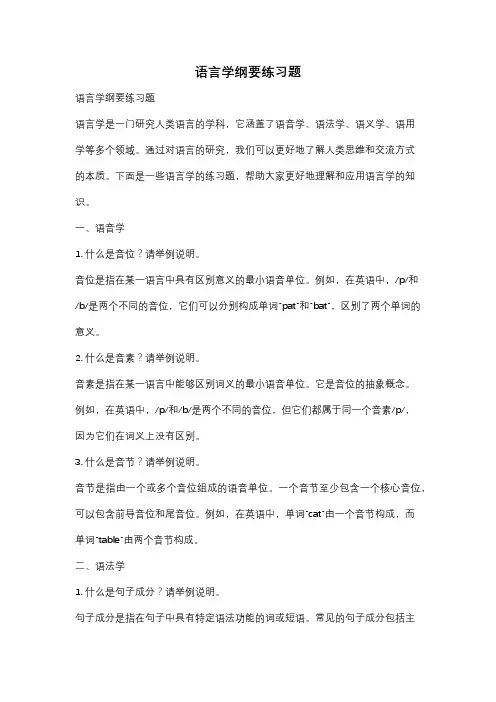
语言学纲要练习题语言学纲要练习题语言学是一门研究人类语言的学科,它涵盖了语音学、语法学、语义学、语用学等多个领域。
通过对语言的研究,我们可以更好地了解人类思维和交流方式的本质。
下面是一些语言学的练习题,帮助大家更好地理解和应用语言学的知识。
一、语音学1. 什么是音位?请举例说明。
音位是指在某一语言中具有区别意义的最小语音单位。
例如,在英语中,/p/和/b/是两个不同的音位,它们可以分别构成单词"pat"和"bat",区别了两个单词的意义。
2. 什么是音素?请举例说明。
音素是指在某一语言中能够区别词义的最小语音单位。
它是音位的抽象概念。
例如,在英语中,/p/和/b/是两个不同的音位,但它们都属于同一个音素/p/,因为它们在词义上没有区别。
3. 什么是音节?请举例说明。
音节是指由一个或多个音位组成的语音单位。
一个音节至少包含一个核心音位,可以包含前导音位和尾音位。
例如,在英语中,单词"cat"由一个音节构成,而单词"table"由两个音节构成。
二、语法学1. 什么是句子成分?请举例说明。
句子成分是指在句子中具有特定语法功能的词或短语。
常见的句子成分包括主语、谓语、宾语、定语、状语等。
例如,在句子"The cat is sleeping on the mat."中,"The cat"是主语,"is sleeping"是谓语,"on the mat"是状语。
2. 什么是句法树?请举例说明。
句法树是一种用来表示句子结构的图形工具。
它通过树状结构展示了句子中各个成分之间的关系。
例如,对于句子"The cat is sleeping on the mat.",句法树的表示可以是:[S]/ \[NP] [VP]/ \ / \[Det] [N] [V] [PP]| |[is] [P]|[NP]/ \[Det] [N]|[the]三、语义学1. 什么是词义?请举例说明。
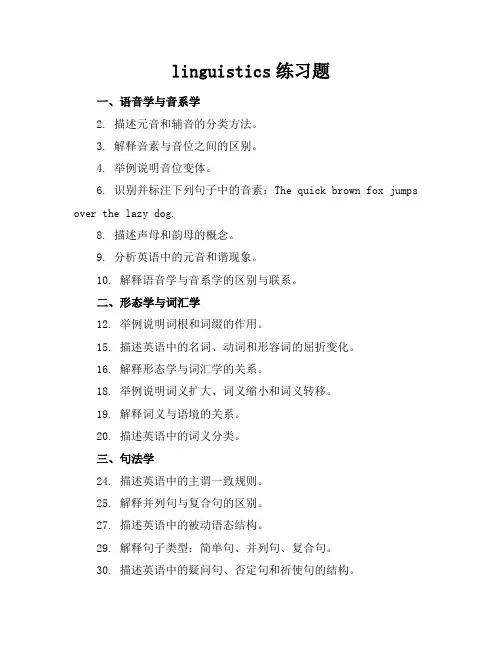
linguistics练习题一、语音学与音系学2. 描述元音和辅音的分类方法。
3. 解释音素与音位之间的区别。
4. 举例说明音位变体。
6. 识别并标注下列句子中的音素:The quick brown fox jumps over the lazy dog.8. 描述声母和韵母的概念。
9. 分析英语中的元音和谐现象。
10. 解释语音学与音系学的区别与联系。
二、形态学与词汇学12. 举例说明词根和词缀的作用。
15. 描述英语中的名词、动词和形容词的屈折变化。
16. 解释形态学与词汇学的关系。
18. 举例说明词义扩大、词义缩小和词义转移。
19. 解释词义与语境的关系。
20. 描述英语中的词义分类。
三、句法学24. 描述英语中的主谓一致规则。
25. 解释并列句与复合句的区别。
27. 描述英语中的被动语态结构。
29. 解释句子类型:简单句、并列句、复合句。
30. 描述英语中的疑问句、否定句和祈使句的结构。
四、语义学与语用学33. 解释语义学与语用学的区别与联系。
34. 描述英语中的情态动词及其意义。
36. 解释语境对句子意义的影响。
38. 描述英语中的礼貌用语及其功能。
39. 解释隐喻和转喻的概念。
五、语言习得与语言学应用41. 描述儿童语言习得的过程。
42. 解释二语习得与母语习得的差异。
44. 描述语言教学中的交际法、任务型教学法等。
45. 解释语言测试的类型及其功能。
47. 描述跨文化交际中的语言障碍。
48. 解释语言规划与语言政策的概念。
50. 描述语言与认知、情感、社会等因素的关系。
六、历史语言学51. 描述语言变化的主要类型及其原因。
52. 解释语言演化的连续性与非连续性。
53. 分析英语历史上的重大语言变革。
54. 识别并解释古英语与现代英语之间的差异。
55. 描述语言学中的比较法及其在历史语言学中的应用。
56. 解释历史语言学与历时语言学的区别。
58. 描述语言接触对语言变化的影响。
59. 解释语言死亡的概念及其原因。
语音理论测试题及答案语音学是语言学的一个分支,它研究人类语言的发音机制、声音的物理属性以及语音在语言中的功能。
本文将提供一系列语音理论的测试题及答案,以帮助学习者更好地理解和掌握语音学的基本概念。
一、选择题1. 语音学研究的主要对象是什么?A. 语言的书写形式B. 语言的发音机制C. 语言的语法结构D. 语言的词汇意义答案:B2. 下列哪项不是语音学中的基本概念?A. 音素B. 音节C. 语调D. 词汇答案:D3. 发音时,声带不振动产生的语音属于哪一类?A. 浊音B. 清音C. 塞音D. 擦音答案:B二、填空题4. 语音学中的最小音位单位是________。
答案:音素5. 当我们谈论一个音素的发音特征时,我们通常指的是它的________、________和________。
答案:发音部位、发音方式、音质三、判断题6. 所有语言的音素数量都是相同的。
答案:错误。
不同语言的音素数量各不相同。
7. 语音的物理属性包括音高、音强和音长。
答案:正确。
四、简答题8. 简述什么是音位对立,并给出一个例子。
答案:音位对立是指在特定语言中,两个音素在发音上的差异足以改变词的意义。
例如,在英语中,/p/和/b/是音位对立的,因为它们在词首可以区分词的意义,如“pat”和“bat”。
9. 解释什么是同位异音现象,并给出一个例子。
答案:同位异音现象是指在某些语言中,同一个音位在不同的发音环境中可能会有不同的发音表现。
例如,在英语中,字母“c”在“ce”之后通常发/s/音,如“cell”,而在“ca”之后发/k/音,如“cat”。
五、论述题10. 论述语音学在语言教学中的重要性。
答案:语音学在语言教学中扮演着至关重要的角色。
首先,它帮助学习者理解语言的发音规律,从而更准确地模仿和掌握目标语言的发音。
其次,语音学知识可以帮助学习者识别和区分音素,这对于听力理解尤为重要。
此外,语音学还能够增强学习者的语言意识,使他们能够更有效地使用语言进行沟通。
英语语言学第五章练习题英语语言学第五章通常涉及语音学和音系学的内容,以下是一些练习题供学生练习:练习题一:音标识别1. 请识别下列单词的音标,并写出它们的国际音标(IPA)符号。
- cat- dog- book- car练习题二:音素对比2. 比较下列单词中的元音音素,并指出它们在发音上的不同。
- sheep / ship- meet / meat练习题三:音节划分3. 将下列单词划分音节,并标注每个音节的重音。
- beautiful- international练习题四:同化和异化现象4. 给出英语中同化和异化现象的例子,并解释它们是如何发生的。
- 同化(Assimilation):- 异化(Dissimilation):练习题五:连读和失爆5. 描述英语中的连读(Liaison)和失爆(Epenthesis)现象,并给出例子。
- 连读:- 失爆:练习题六:音位变体6. 解释什么是音位变体,并给出英语中的音位变体例子。
- 音位变体(Allophone):练习题七:最小对立组7. 列出英语中的最小对立组,并说明它们是如何区分意义的。
- 例如:/ p / 和 / b / 在 "pat" 和 "bat" 中的区别。
练习题八:音系规则8. 描述音系规则的概念,并给出一个英语中的音系规则例子。
练习题九:音位和音素9. 解释音位(Phoneme)和音素(Phone)的区别,并给出例子。
练习题十:语音变化10. 讨论英语中的几种语音变化现象,如元音的缩短和延长,并给出例子。
请注意,这些练习题需要学生具备一定的英语语音学基础知识,以便能够正确完成。
希望这些练习题能够帮助学生加深对英语语音学的理解。
30道语音学练习题1.V oiceless and voiced consonants can be differentiated by_______.A. manner of articulationB. openness of mouthC. obstruction of airflowD. vibration of vocal cord答案: D。
解析:清辅音(voiceless consonant)和浊辅音(voiced consonant)的区别主要是看声带是否振动(vibration of vocal cord)。
故选D项。
##2.English consonants can be classified into bilabial, dental, alveolar, etc., in terms of_______.A. manner of articulationB. openness of mouthC. place of articulationD. voicing答案: C。
解析:bilabial, 双唇音dental, 齿音alveolar,齿槽音,把辅音分成以上这些类别是依据发音的位置来区分,即发音过程中牵涉到不同位置的发音器官,从而产生不同类别的辅音。
故选C项。
##3.According to the manner of articulation, English consonants can be classified into the following groups EXCEPT_______.A. V oicingB. PalatalC. NasalityD. Obstruent答案B。
解析:根据发音的方式,英语辅音可以分成浊化音(voicing),鼻音(nasality),塞音(obstruent)。
而B项中的palatal指的是软腭音,是按照发音位置来区别的而非是发音方式。
语音考试题及答案一、选择题(每题2分,共20分)1. 语音学中,音素是指:A. 语言中最小的意义单位B. 语言中最小的语音单位C. 语言中最小的语法单位D. 语言中最小的书写单位答案:B2. 下列哪个选项中的词语发音完全相同?A. 鱼、雨、语B. 吃、尺、迟C. 书、梳、舒D. 知、支、织答案:A3. 汉语普通话中,声母“j”的发音特点是:A. 舌尖前音B. 舌面音C. 舌尖后音D. 舌根音答案:C4. 汉语拼音中,“ü”的发音与下列哪个元音相似?A. [i]B. [u]C. [e]D. [o]答案:B5. 汉语普通话中,下列哪个声母是浊音?A. bB. pC. mD. f答案:C6. 下列哪个词语的声调标注不正确?A. 妈(mā)B. 麻(má)C. 马(mǎ)D. 骂(mà)答案:B7. 汉语普通话中,轻声的特点是:A. 声调不明显B. 声调与第四声相同C. 声调与第一声相同D. 声调与第二声相同答案:A8. 汉语拼音中,“ng”是:A. 声母B. 韵母C. 声调D. 隔音符号答案:A9. 下列哪个词语的声母是“n”?A. 你B. 了C. 来D. 了答案:A10. 汉语普通话中,下列哪个词语的韵母是“iao”?A. 脚B. 叫C. 教D. 桥答案:C二、填空题(每题2分,共20分)1. 汉语普通话中,声母“z”的发音部位是_________。
答案:舌尖前音2. 汉语拼音中,“ai”的发音与英语中的_________相似。
答案:eye3. 汉语普通话中,声母“f”的发音特点是_________。
答案:唇齿音4. 汉语普通话中,韵母“ie”的发音特点是_________。
答案:前高不圆唇元音5. 汉语普通话中,声母“g”的发音特点是_________。
答案:舌根音6. 汉语拼音中,“ü”的发音与英语中的_________相似。
答案:book7. 汉语普通话中,轻声的调值是_________。
汉语语音学课堂练习1.指出下列音是浊音、瞬音还是紊音,或是混合类型?[t]瞬、[ts]瞬紊、[]紊、[a]浊、[b]浊瞬、[w]浊不典型紊音2.国际音标和汉语拼音有什么不同?音素符号/音位符号:一音一符,一符一音,全球一致/一符多音,限于汉语普通话,不能记录方言和其他语言。
3.发音器官可分为哪几部分,它们在发音时各起什么作用?动力/发声体/调制不同音色4.声调的高低升降和曲折是怎样产生的?勺状软骨控制声带松紧,5.为什么同一个人能发出不同音色的元辅音?口腔形状不同调制、阻碍部位和方法不同而调制6.发元音和发辅音有什么不同?有无阻碍、部位紧张、气流强弱7.根据对发音部位和发音方法的描述写出下列辅音(用国际音标):(1)双唇清送气塞音[ph](2)舌尖前上齿背清不送气塞擦音[ts](3)舌面后软腭鼻音[](4)舌尖中上齿龈边音[l](5)舌面前硬腭前清擦音[](6)唇齿清擦音[f](7)舌尖后硬腭前半元音[]8.根据下面的描述写出元音(用国际音标):(1)舌尖前不圆唇元音[](2)舌面前半高不圆唇元音[e](3)舌面后半高圆唇元音[o](4)舌面中央元音[](5)舌面低央元音[]9.说明下列辅音的发音部位和发音方法:[kh] 舌面后软腭清送气塞音[t] 舌面前硬腭前清不送气塞擦音[m] 双唇鼻音[tsh] 舌尖中上齿背清送气塞擦音[] 舌尖后硬腭前清擦音[t] 舌尖中上齿龈清不送气塞音10.请描述下列元音:[]舌尖后不圆唇元音[i] 舌面前高不圆唇元音[y] 舌面前高圆唇元音[a] 舌面前低不圆唇元音[]舌面后半高不圆唇元音[]舌面中央卷舌元音11.写出与[]同部位的音。
12.写出与[n]同发音方法的音。
13.分析下列音节的结构:14.汉语的字调语调都要加在同一个音节上,它们是怎样配合的?15.请举五对用轻音区别意义的词(例:东西—东西)和五个读轻音但不区别意义的词。
16.请举例说明汉语的自然音步,自然音步对汉语书面语选词造句有什么要求?大量使用双音节词或四字格,越是庄重、书面语色彩浓越大量用。
语言学音系学试题及答案一、选择题(每题2分,共20分)1. 音系学是研究语言中的什么现象?A. 语法结构B. 词汇意义C. 语音系统D. 语用功能答案:C2. 以下哪个术语是描述音位的最小对立单位?A. 音素B. 音节C. 音位D. 音标答案:A3. 在音系学中,同位异音指的是什么?A. 同一个音位的不同发音B. 不同音位的相同发音C. 同一个词的不同发音D. 不同词的相同发音答案:A4. 音系规则是什么?A. 描述音位之间关系的规则B. 描述词义之间关系的规则C. 描述语法结构的规则D. 描述词序的规则答案:A5. 以下哪一项不是音系学的研究对象?A. 音位B. 语调C. 语法D. 音节答案:C二、填空题(每题2分,共20分)1. 音系学中的最小语音单位是________。
答案:音素2. 音系学中的音位变体称为________。
答案:同位异音3. 音系学中的________规则描述了音位之间的系统性关系。
答案:音系4. 音系学中的________现象指的是在不同语境中,同一个音位可以有不同的发音。
答案:互补分布5. 在音系学中,________指的是音位在特定语音环境中的发音变化。
答案:音位变体三、简答题(每题10分,共30分)1. 简述音系学与语音学的区别。
答案:音系学是研究语言中音位的系统性规律,而语音学是研究人类语音的物理属性和发音机制。
2. 描述音位和音素之间的关系。
答案:音素是语音学中的最小单位,而音位是音系学中的最小单位,音位是由一组音素构成的,它们在特定语言中具有相同的功能。
3. 解释什么是音系规则,并给出一个例子。
答案:音系规则是描述音位之间如何相互作用的规则。
例如,在英语中,清音在词末的发音往往会变为浊音,如“cat”和“cats”中的“t”发音不同。
四、论述题(每题30分,共30分)1. 论述音系学在语言习得和教学中的作用。
答案:音系学在语言习得和教学中起着重要作用。
它帮助学习者理解语言的音位系统,从而更好地掌握发音规则。
第2章语音学和音位学
Phonetics&Phonology
1.phonetics is the study of_______.
A.all the sounds that occur in the world’s languages
B.sppech sounds used by human languages to represent
C.the differernces between sounds used in human languages and sounds in nature
D.how phonological differences can lead to misunderstanding
2./m, n/ are ____.
A.fricatives
B.dentals
C.glides
D.nasals
3./w, j/ belong to ____.
A.fricatives
B. dentals
C. glides
D. nasals
4.Which of the following vowel is the rounded vowel?
A.[i:]
B.[u:]
C.[i]
D.[a:]
5.In the field of phonology, which of the following does NOT belong to the suprasegmental
features?
A.stress
B.tone
C.intonation
D.syllable
6.Classification of vowels are made up of the followings EXCEPT____.
A.the position of the tongue
B.the openness of the mouth
C.The shape of the lip
D.The width of the vowels
7. A sound which is capable of distinguishing one word or one shape of a word from another in a
given language is a______.
A.phoneme
B.allophone
C.phone
D.allomorph
8./p, t, k / are______.
A.fricatives
B. affricates
C. glides
D.stops
9./kuku:/ is a bird’s call. The name of such a bird is CUCKOO which is an example of ______.
nguage universals
B.onomatopoeia
C.teaching grammars
D.morphs
10.The vowel [u:] in [fu:d] (food) is a____ vowel.
A.back
B.front
C.unrounded
D.central
11.In English, there is only one glottal. It is ____.
A.[f]
B.[r]
C.[h]
D.[v]
12.Which of the following sounds is a voiced bilabial stop?
A.[m]
B.[v]
C.[p]
D.[b]
13.The different phones which can represent a phoneme in different phonetic environments are
called the ____ of that phoneme.
A.minimal
B.allomorph
C.phones
D.allophones
14.[i:],[i],[e] are all ____ vowels.
A.front
B.central
C.back
D.high
15.Which of the following is a fricative sound?
A.[m]
B. [p]
C. [w]
D. [v]
16. there are ___ nasals in English.
A .one
B. two
C. three
D. four
17. ___ are not a minimal pair in Engliah.
A” sink” and “zinc” B. “fine” and “vine”
C. “bat” and “pat”
D. “teach” and “cheat”
答案:
1-5 ADCBD 6-10 DADBA 11-15 CDDAD 16-17 CD。